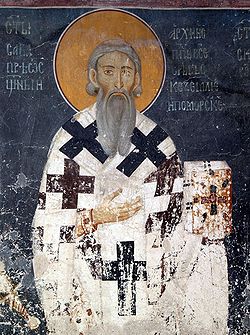Top Qs
Timeline
Chat
Perspective
January 12 (Eastern Orthodox liturgics)
Day in the Eastern Orthodox liturgical calendar From Wikipedia, the free encyclopedia
Remove ads
January 11 - Eastern Orthodox liturgical calendar - January 13

All fixed commemorations below are observed on January 25 by Eastern Orthodox Churches on the Old Calendar.[note 1]
For January 12th, Orthodox Churches on the Old Calendar commemorate the Saints listed on December 30.
Feasts
- Afterfeast of the Theophany of Our Lord and Savior Jesus Christ.[1][2]
Saints
- Martyr Tatiana of Rome, and those who suffered with her (c. 222 - 235)[1][3][4][note 2]
- Martyr Mertius of Mauretania (284–305)[1][6][7]
- Martyr Philotheus of Antioch (c. 305)[1][8]
- Martyr Peter Apselamus of Eleutheropolis in Palestine (309)[1][9][10] (see also January 13, and October 14[11])
- Venerable Eupraxia of Tabenna in Egypt (393)[1][12][13]
- Saints Tygrius the Presbyter, and Eutropius the Lector, at Constantinople (c. 395 - 408)[5][14] (see also: June 16)
- Holy Eight Martyrs of Nicaea, by the sword.[1][15]
- Virgin-Martyr Euthasia, by the sword.[16][17]
- Venerable Elias the Wonderworker of Egypt, Desert Father (4th century)[1][17][18] (see also January 8)
- Venerable Theodora of Alexandria, instructress of nuns (5th century)[1][17][note 3]
Remove ads
Pre-Schism Western saints
- Saint Arcadius of Mauretania, a prominent citizen of Caesarea in Mauretania Caesariensis, barbarously martyred under Maximianus Herculeus (c. 302)[5][20][21]
- Martyrs Zoticus, Rogatus, Modestus, Casutlus, between forty and fifty soldiers, in Africa.[5][20][22]
- Saint John of Ravenna (Giovanni I Angelopte), Bishop of Ravenna and Confessor (494)[5][20][note 4]
- Saint Caesaria, the gifted sister of St Caesarius of Arles and Abbess of the convent founded there by her brother (c. 530)[20]
- Saint Victorian of Asan, founder and abbot of the monastery of Asan (now called San Vitorián) (c. 560)[20]
- Saint Probus, Bishop of Verona in Italy (c. 591)[5][23]
- Saint Eilian of Rome (Eilian of Anglesey), (6th century)[24][note 5] (see also January 13)
- Saint Salvius (Sauve), Bishop of Amiens, his relics were enshrined in Montreuil in Picardy (c. 625)[20]
- Saint Benedict Biscop, Abbot of Wearmouth and Confessor (690)[1][5][20][25]
Post-Schism Orthodox saints
- Saint Sava I, Enlightener and first Archbishop of Serbia (1235)[1][26] (see also: January 14 - Greek)
- Venerable Martinian of White Lake, Abbot (1483)[1][27][28]
- Venerable Galacteon, disciple of St. Martinian of White Lake, Fool for Christ (1506)[1][29][30]
- Venerable Archimandrite Theodosius of Tisman and Sophroniev Monasteries, fellow-struggler of St. Paisius Velichkovsky (1802)[31]
- Saint John of Tula, Fool-for-Christ (1850)[1][32]
Remove ads
Other commemorations
- Synaxis of the Icon of the Most Holy Theotokos "The Milk-giver" (Panagia Galaktotrofoussa; Mlekopitatelnica).[1][33][34]
- Synaxis of the Icon of the Most Holy Theotokos "Akathist".[35][36]
- Synaxis of the Icon of the Most Holy Theotokos "Mesopantitissis" in Crete (Theotokos of Mesopantitissis).[37][note 6]
- Icon of the Mother of God "Priestly" (Popskaya).[38][39]
- Commemoration of the Church of St. Alexander, near the Church of the Holy Apostles, in Constantinople.[40]
Remove ads
Icon gallery
- Martyrdom of St. Tatiana of Rome
(Menologion of Basil II, 10th century) - St. Tatiana of Rome.
- Saint Arcadius of Mauretania, martyr.
- Monastery of Saint Victorian of Asan.
- St. Benet (Benedict Biscop) carrying St. Peter's Basilica to Britain.
- Fresco of Saint Sava, King's Church in Studenica, Serbia
Notes
- The notation Old Style or (OS) is sometimes used to indicate a date in the Julian Calendar (which is used by churches on the "Old Calendar").
The notation New Style or (NS), indicates a date in the Revised Julian calendar (which is used by churches on the "New Calendar"). - "Bishop of Ravenna in Italy from 452 to 494. He saved his flock from the fury of Attila the Hun and mitigated its lot when the city was taken by Theodoric, King of the Ostrogoths."[20] Andreas Agnellus lists only one bishop of Ravenna with this name in the 5th century. Although Agnellus mistakenly assigns events dated to the earlier part of the century to John's office, John's surviving epitaph (CIL 11, 304) states he was bishop 16 Years, ten months and 18 days, and was buried 5 June 494.
- Saint Eilian (Eilianus) came from Rome and lived around the 6th century AD. He came to Britain, where he lived as a hermit in the area north of Anglesey, and venerably reposed in peace.
- The holy icon of "Panagia Mesopantitissis" was brought to Crete from Constantinople during the Iconoclastic period, in order to save it from the impious fury of the iconoclasts. According to Holy Tradition it was painted by St. Luke the Apostle. During the period of Venetian rule in Crete, it was kept in the Temple of the Holy Apostle Titus in Heraklion. Every Tuesday pious Christians prayed a litany before the holy icon. When Heraklion was captured by the Hagarenes, the Venetians took the venerable icon of the Virgin Mary and transferred it to Venice, where they placed it in the Church of the Most Holy Theotokos of the Salutations, where it has been kept there until today. A copy of the Holy Icon can be found in the Church of the Holy Apostle Titus in Heraklion, where the feast of the Synaxis of this icons is celebrated.
Remove ads
References
Sources
Wikiwand - on
Seamless Wikipedia browsing. On steroids.
Remove ads






